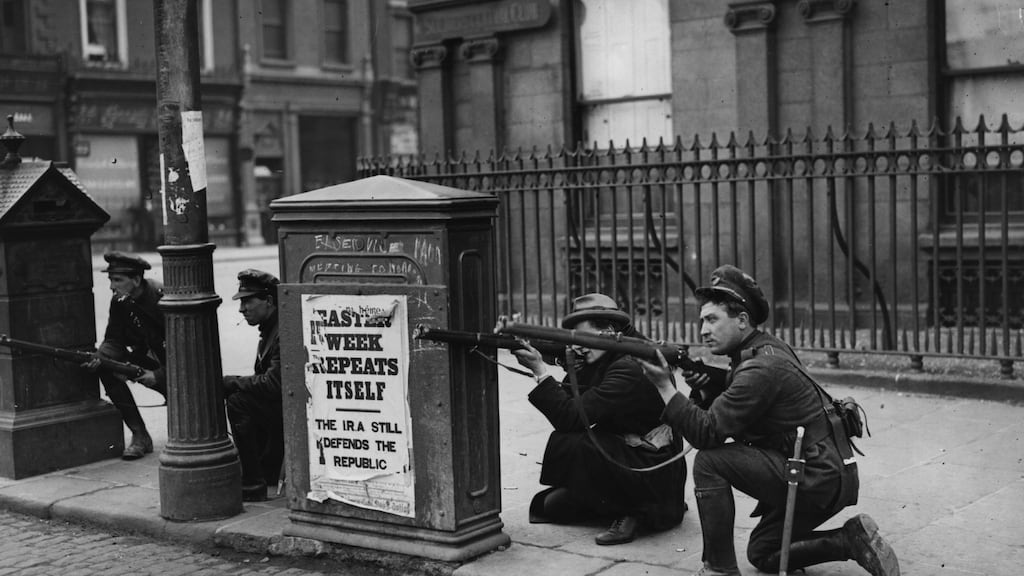Ireland should desist from mythologising war and instead speak of it in all its horror and pain as the country continues with its commemorations of events from the revolutionary period, award-winning journalist Fergal Keane has urged.
Mr Keane, who was officially diagnosed with complex post-traumatic stress disorder due to repeated exposure to incidents as a war correspondent, said it was his personal experience that had encouraged him to have a retrospective compassion for those caught up in the Troubles.
“We must speak of war as it actually is, put all mythologising to one side, make the moral leap and see the blood pooling on the kitchen floor, the scattering of flesh in the branches, the haunted days and nights of those who live on after wars,” he said.

Mr Keane questioned whether young men chanting UVF or IRA slogans would be so vocal if they knew the reality of war. “Perhaps a few would but most, I would argue, would recoil from their jingoism and recognise the pain it causes to those living with the trauma of the Troubles.”
Delivering the closing address remotely at this year’s West Cork History Festival, Mr Keane said it was imperative that people today seek to come to terms with the trauma of the Troubles in a way they never did with the War of Independence and Civil War almost 100 years ago.
Healing of trauma
“If trauma is to be overcome in the north of Ireland, there will and there already are, many journeys to be undertaken – the journeys that could not be undertaken in the south after the War of Independence and the Civil War,” he said.
“The healing of trauma is not only an individual journey, it needs to be supported – most obviously by the medical services of a state, by the efforts of voluntary support groups – but also by governments and by society at large which accept that the costs of conflicts can endure for generations.”
Mr Keane said that his own experience of conflict began when he started covering the Troubles, which in turn led him to report from war-torn Rwanda, Iraq and Afghanistan but he realised that what drew him to such a career were stories from the Irish Revolution that he heard as a child.
"From a very early age, I was conscious of the idea of the history of those times. It was a story of heroism, of daring escapes from the enemy, a grandmother and granduncle, who fought the Black and Tans, who worshipped Michael Collins and took his side in the Civil War," he said.
Heroic narrative
Occasionally complicating questions would intrude on this world of gaunt men in trenchcoats hiding in bogs and lonely farmhouses such as those stemming from the fact that while he had a maternal grandfather fighting with the IRA in Cork, that man’s own father served in the RIC.
The shooting dead by the IRA of District Inspector Tobias O'Sullivan near the Keane home in Listowel within sight of his family home, where his wife and children waited to welcome him back, was another troubling intrusion on the simple heroic narrative of the Irish Revolution.
“The blood was missing – the mess of mutilated bodies that I have seen in so many places in our time was never part of what I learned, much less the anguish of nightmares, alcoholism and depression which consumed some who had been victims and some who had been perpetrators.”
Mr Keane said that it was only by accessing the military archives at Cathal Brugha Barracks in Dublin and reading the reports that he began to get a clear picture of the psychological cost of the conflict which lasted in the south from 1916 until 1923.
He said in looking at the war that shaped his forebears, he was seeking facts rather than “the stifling shroud of victimhood … I want to know what happened to my own people, the forces that shaped their minds and what they may have passed on to the generations that came after.”
The murder of District Inspector O’Sullivan from Cornamorna in Co Galway on January 20th, 1920, as he walked home with his five-year-old son by his side, traumatised a family for generations while it “also haunted some of the men who had murdered him”, he said.
The IRA execution of suspected informer, retired RIC Sergeant James Kane, on suspicion of passing information to the RIC which led to the killing of three unarmed IRA men by the Black and Tans at Gortaglanna near Knockanure in May 1921, was another hugely traumatic event, he said.
Mr Keane told how Volunteer Brian O’Grady later related in a witness statement how they executed Kane, after promising to leave his body as close as possible to his home town of Listowel, as well as delivering his will and a letter of farewell to his children, who had already lost their mother.
“The condemned man and his executioners knelt and said the rosary together – he was blindfolded (and) shot by four men. A note warning ‘Spies Beware’ was attached to his body, which was left where he had fallen,” recalled Mr Keane.
"The killers walked back through the fields. Nobody seems to have spoken until they reached a safe distance from the road when O'Grady remarked to (his comrade) Denis Quill that 'a brave man died tonight'. 'I thoroughly agree with you,' Quill replied."
Haunted by experiences
Mr Keane said he knew two of the men, who took part in the killings of DI O'Sullivan and James Kane, were haunted by the events long afterwards and he instanced how IRA man and Kerry football hero Con Brosnan used to pray every day for the men he killed and later suffered from depression.
Acknowledging he was engaging in speculation, he said he wondered if people like Con Brosnan and his own grandmother, Hannah Purtill, who had no previous experience of violence and no access to any kind of mental health services, could not have been unaffected by their experiences.
The Civil War brought an even greater level of violence to Kerry than that experienced during the time of the Black and Tans when prisoners were murdered by being tied to landmines and blown to pieces and bayoneted in prison cells, and surrendering men were shot and thrown down cliffs.
After the Civil War, there was simply no room within the newly established Free State to consider the emotional needs of those who had fought in the IRA, the RIC, the Free State Army or among the Anti-Treaty forces who lived with nightmares, flashbacks and depression.
Nor was it possible to create a collective memory as while the files in the Military Archives illuminate a world of pain, they are largely devoted to the experiences of those fighting for the Revolution. “There is, for the most part, a great silence where the voices of the defeated are concerned.”
The lessons from the revolutionary period clearly show that urging the survivors of more recent atrocities in the North to simply move on and find closure is not enough but people should avoid seeking to mythologise the conflict but instead strive for openness about its psychological costs.











